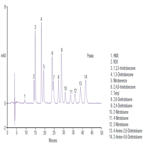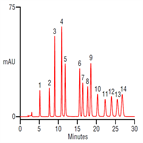Find methods for your needs
Refine by Feature
Displaying 1-5 of 10 results for Tag: Explosive
AN328: Extraction of Explosives from Soils by Accelerated Solvent Extraction (ASE)
Instrument Type: Automated Sample PrepCompounds used in high explosives may be toxic, carcinogenic, and are found on the Resource Conservation and Recovery Act (RCRA) list. These compounds and their metabolites are monitored in soils and ground waters to ensure compliance with U.S. EPA regulations. This application note reports on the use of ASE for the extraction of explosive compounds such as HMX, RDX, 2,4,6-trinitrotoluene (TNT), and some of their known metabolites from soils.
AN1086: Automated Solid Phase Extraction of 14 Explosives in Tap Water Based on U.S. EPA Method 8330 Using Hydrophilic Reversed-Phase Cartridge
Instrument Type: HPLCThe U.S. EPA Method 8330, first introduced in November 1990, is the most common method for the analysis of explosives. Analytes can be detected down to 2.5 ppb in water, soil, or sediment. Used here are the Thermo Scientific Dionex AutoTrace 280 Solid-Phase Extraction (SPE) instrument and the Thermo Scientific Dionex SolEx SPE HRPHS cartridge to concentrate the explosive residues, followed by HPLC.
Simultaneous UHPLC/MS Analyses of Explosive Compounds
Instrument Type: LCMSWe describe an ultra high performance liquid chromatography/mass spectrometry (UHPLC/MS) method to efficiently separate, detect and quantitate all four classes of explosive compounds in soil samples, including eight nitroaromatics, two nitroamines, five nitrate esters and two peroxides. The explosives were separated on a Thermo Scientific Hypersil GOLD PFP, 1.9 µm, 2.1 x 100 mm column and detected by selected ion monitoring (SIM) on an Thermo Scientific MSQ Plus Mass Detector – a fast scanning, single-quadrupole mass spectrometer.
High resolution analysis of ISO 22478 explosives
Instrument Type: HPLCThe Thermo Scientific UltiMate 3000 HPLC system is applied for the analysis of ISO 22478 explosives. The separation is performed on a Thermo Scientific Acclaim Explosives E2 column, with UV detection at 210 and 254 nm.
High resolution analysis of explosives for EPA method 8330A
Instrument Type: HPLCThe Thermo Scientific HPLC system is applied for the analysis of explosives by EPA method 8300A. The separation is performed on a Thermo Scientific Acclaim Explosives E2 column, with UV detection at 254 nm.





